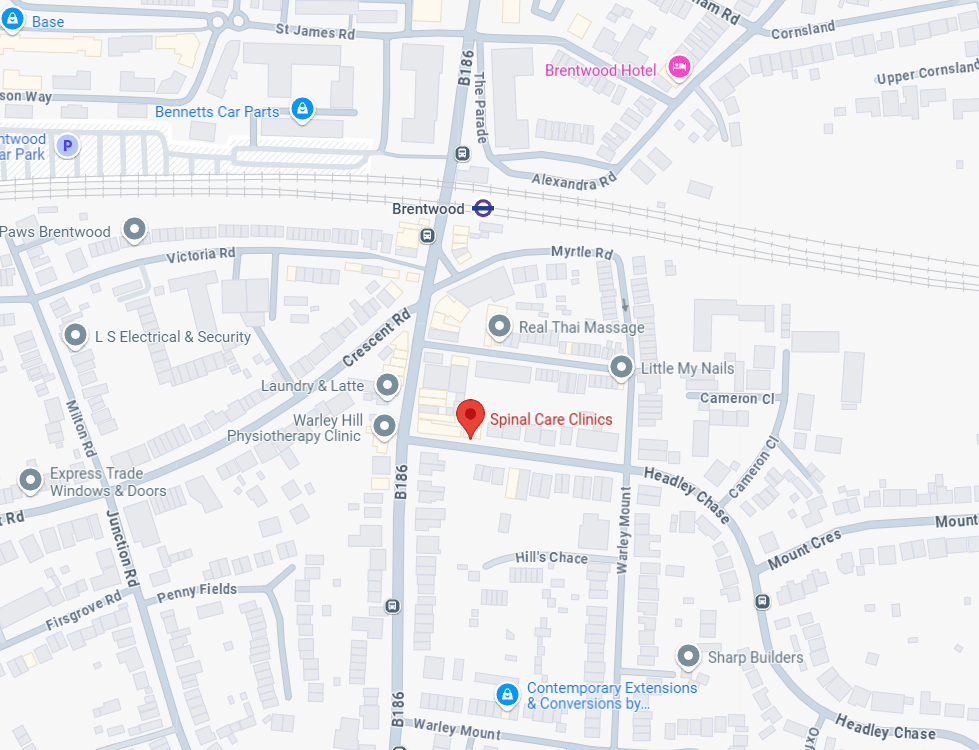
Darwin’s theory shows that we have evolved from a four-legged animal to one that now stands progressively taller. However, if you take a look around, you’ll soon notice the slouchers. It seems as though, with all our technological advancements, we are somehow regressing, moving down the line in the famous image depicting man’s evolution.
Plain and simple, good posture is key to great health.

Your spine encases the nervous pathway that connects your central nervous system to its periphery. This basically means that each bone in your spine needs to be perfectly aligned with its neighbours to allow seamless communication and avoid painful conditions such as sciatica and herniated discs.
We see many people at Spinal Care Clinics in Brentwood with acute or chronic back pain who believe it’s the result of a false movement or a sudden unknown injury. However, many don’t realise that the most common cause of lower back pain is postural stress – AKA BAD POSTURE.
There are many ways to develop poor posture and we’re taking a look at some of the most popular habits putting your back health at risk.

Slouching
You’re probably aware of this one. Many of us grow-up hearing ‘sit-up straight’ as a child, and then, into our young adulthood, we lose this constant posture reminder. It’s easy to hunch over a screen, but in doing so, you’re putting a lot of stress on your neck.
Your spine is made of 33-stacked vertebrae separated by shock absorbing pads known as discs. By arching forward repetitively and for long periods of time, the gap between the vertebrae narrows at the front, becoming compressed, while the back opens-up. This means the pads become unevenly distributed and, in certain cases, it can easily bulge out, compressing nerves and creating a herniated disc. Ouch!
Tip
Sitting at a desk for hours on end is bad for your back, but this is the way the world is going and we need to work with it. Bringing your screen to eye level will place your spine into a neutral position.
If you find your desk a little too high for you, try a footrest, but remember that your hips should be slightly higher than your knees.

Body language and stress
Your mood has a lot do with the way you stand – it’s even embedded in our language! Do you want to be an upstanding citizen and walk tall or stand proudly? Or would you rather slouch, collapsed and defeated?
In stressful situations muscles tend to tense and spasm and our body seems to hunch or clamp-up, creating an invisible wall to match the one in our head.
Many studies have revealed a strong link between posture and mood. Results show that we naturally sit upright when telling a story that brings back happy memories and slouch when sharing our worries. So if you’re feeling stressed internally, the chances are it will also be obvious externally.
Tip
Happiness leads to smiling and smiling leads to happiness. Awareness is key and if you’re feeling stressed at work or at home, try tricking your mind into feeling cool and confident by looking that way.


Bags
We’ve made tech advancements where our entire life can be stored in an ultra thin phone, yet we still manage to carry heavy bags. Do you sling your backpack, laptop bag, or purse over the same shoulder?
Students, shoppers and people of the corporate world are most at risk. Carrying a bag on one shoulder distributes the weight unevenly on your spine and that’s a recipe for shoulder, neck and back pain.
Tip
Always keep spinal alignment and balance in mind. If you’re shopping, distribute the weight evenly between bags. Backpacks are much better for this reason, but if you really must use a shoulder bag, then be sure to switch sides frequently.

Resting standing pose
This is usually the most surprising. How do stand when you’re chatting to a friend, in a meeting or waiting for a train? Many feel awkward with their hands dangling at their sides so they cross their arms or reach for a phone. Others stick a leg out to the side as if to mark their piece of public territory. These postures aren’t great, they also mess with spinal alignment
Tip
In this case, lower back pain is usually related to a weakened core. The increased pressure on your spine can tighten and spasm lower back muscles. If you spend long hours standing daily, adding core training exercises and stretches should certainly help with the pain.
Chiropractors perform gentle adjustments to realign the spine. Our aim is not only to correct your posture but also help you maintain good back health in general. In the same way that it took time to acquire bad posture, it will take time and awareness to fix it. So as you finish this article, drop you shoulders, lift your head and take a deep breath – it’s all about baby steps.

